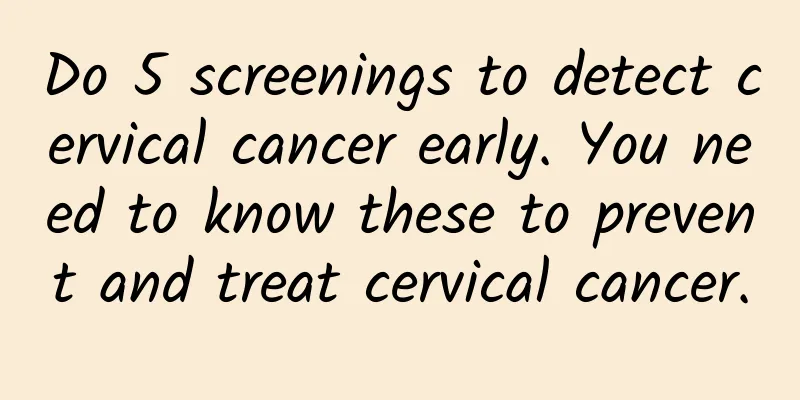Do 5 screenings to detect cervical cancer early. You need to know these to prevent and treat cervical cancer.

|
Although cancer is scary, almost all cancers are currently preventable and curable. For example, cervical cancer can be detected and treated early through physical examinations. Although there are still many defects in the modern treatment of cervical cancer, if female friends can develop the good habit of regular gynecological examinations, they can completely prevent the occurrence of cervical cancer and stay away from the pain of the disease. Effective screening for early detection of cervical cancer 1. Be familiar with the early signs of cervical cancer Contact vaginal bleeding, irregular vaginal bleeding, postmenopausal vaginal bleeding, irregular menstruation, increased vaginal discharge with odor, etc. may be early signs of cervical cancer. Once such symptoms occur, you should go to the hospital as soon as possible to undergo gynecological examination, cytology, colposcopy, cervical biopsy and other related examinations. 2. Actively participate in cervical screening It is entirely possible for women who are already sexually active to detect cervical lesions early by undergoing regular gynecological examinations and using effective screening methods under the guidance of a doctor. 3. Don’t take cervicitis lightly Cervicitis is a common disease among women. Patients often experience increased vaginal discharge with odor, vaginal and vulvar itching, etc. Some patients also experience a small amount of contact vaginal bleeding after intercourse and gynecological examination. When the above symptoms occur and you seek medical attention, if you have never undergone cervical screening or the time for re-screening has expired, you should first undergo cervical cytology examination, HPV test, etc. to exclude cervical cancer or precancerous lesions before considering cervicitis. Otherwise, it is easy to miss the opportunity to diagnose cervical cancer early. 4. Do not refuse cervical examination during pregnancy Pregnant women often develop cervical cancer or precancerous lesions. Patients or doctors often attribute vaginal bleeding during pregnancy to threatened abortion, miscarriage, or placenta previa, and worry that vaginal speculum examination will have adverse effects on the pregnancy. Therefore, they fail to conduct necessary examinations on those who have vaginal bleeding during pregnancy, resulting in delayed diagnosis. 5. Diagnosis through pathological examination When doctors suspect that there is a lesion in the cervix and the cytology test is abnormal, they need to use biopsy forceps to take a bite biopsy of the cervical lesion under direct vision or colposcopy, and can take one or more points of tissue for pathological examination. Pathological histological diagnosis is the standard for confirming cervical cancer. You should know these to prevent and treat cervical cancer 1. Cervical cancer is closely related to high-risk HPV virus infection and is currently the only gynecological tumor with a clear cause. 2. Studies have shown that 60%-70% of women will be infected with HPV at some stage in their lives, but only about 15% of women will continue to be infected, becoming a high-risk group for cervical cancer. 3. Generally speaking, it takes 5-10 years or even longer from viral infection to precancerous lesions and then to cervical cancer. Intervention at any stage during this period can prevent the disease before it occurs. 4. HPV infection is a sexually transmitted disease in a broad sense. Women who start having sex too early, have too many sexual partners, or take oral contraceptives for a long time will increase the risk of infection. Men with long foreskin will increase the risk of their wives being infected with HPV. 5. If a woman tests positive for the virus, it is recommended that she undergo a cervical biopsy once a year to rule out early lesions; if the HPV index is negative, there is no need for repeated examination within 5 years. |
Recommend
Characteristics of menopausal functional uterine bleeding
Menopausal functional uterine bleeding refers to ...
Getting fatter the more you lose weight? Nutritionist advice: Break these three myths first….
A young girl came to me and said she wanted to lo...
What should patients with cervical condyloma pay attention to in their diet?
What should patients with cervical warts pay atte...
Do you know what are the TCM classifications of pelvic inflammatory disease?
There are many gynecological diseases, and common...
Introduce the typical symptoms of pelvic inflammatory disease
Pelvic inflammatory disease is very harmful. Once...
The reason why the cervix is very enlarged
Severe cervical hypertrophy may be caused by a va...
Are uterine fibroids life-threatening?
Are uterine fibroids life-threatening? Uterine fi...
What complications can cervical erosion cause?
There are many diseases in the female cervix, and...
Amenorrhea, lower back pain, persistent abdominal pain
Amenorrhea, lower back pain and persistent lower ...
What are the symptoms of multiple uterine fibroids? How to treat multiple uterine fibroids?
Multiple uterine fibroids are a very common gynec...
What can I eat to improve pelvic effusion?
Generally speaking, physiological pelvic effusion...
How to reduce the impact of painless abortion on the body?
How to reduce the impact of painless abortion on ...
Why does my stomach hurt like menstruation after abortion? 2 ways to relieve lower abdominal pain
If the pain in the lower abdomen after abortion i...
What are the common types of multiple uterine fibroids?
Multiple uterine fibroids are a type of uterine f...
How to treat premature ovarian failure?
As for the question of whether premature ovarian ...









